Gemini Lake SFF PC Showdown: Intel's June Canyon (NUC7PJYH) and ECS's LIVA Z2 Reviewed
by Ganesh T S on December 20, 2018 8:00 AM ESTBAPCo SYSmark 2018
The Gemini Lake UCFF PCs were evaluated using our Fall 2018 test suite for small-form factor PCs. In the first section, we will be looking at SYSmark 2018.
BAPCo's SYSmark 2018 is an application-based benchmark that uses real-world applications to replay usage patterns of business users in the areas of productivity, creativity, and responsiveness. The 'Productivity Scenario' covers office-centric activities including word processing, spreadsheet usage, financial analysis, software development, application installation, file compression, and e-mail management. The 'Creativity Scenario' represents media-centric activities such as digital photo processing, AI and ML for face recognition in photos and videos for the purpose of content creation, etc. The 'Responsiveness Scenario' evaluates the ability of the system to react in a quick manner to user inputs in areas such as application and file launches, web browsing, and multi-tasking.
Scores are meant to be compared against a reference desktop (the SYSmark 2018 calibration system, a Dell Optiplex 5050 tower with a Core i3-7100 and 4GB of DDR4-2133 memory to go with a 128GB M.2 SATA III SSD). The calibration system scores 1000 in each of the scenarios. A score of, say, 2000, would imply that the system under test is twice as fast as the reference system.

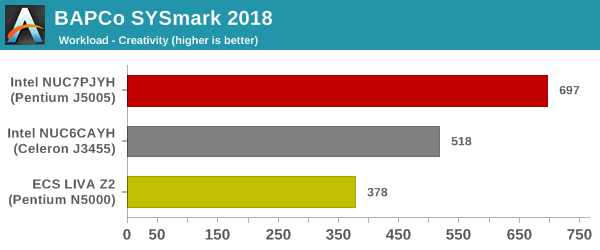
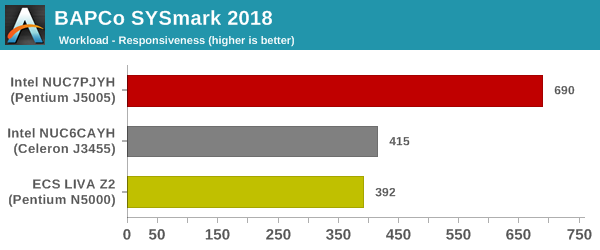
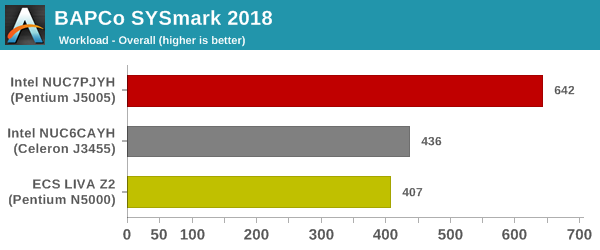
SYSmark 2018 also adds energy measurement to the mix. A high score in the SYSmark benchmarks might be nice to have, but, potential customers also need to determine the balance between power consumption and the efficiency of the system. For example, in the average office scenario, it might not be worth purchasing a noisy and power-hungry PC just because it ends up with a 2000 score in the SYSmark 2014 SE benchmarks. In order to provide a balanced perspective, SYSmark 2018 also allows vendors and decision makers to track the energy consumption during each workload. In the graphs below, we find the total energy consumed by the PC under test for a single iteration of each SYSmark 2018 workload. For reference, the calibration system consumes 5.36 Wh for productivity, 7.71 Wh for creativity, 5.61 Wh for responsiveness, and 18.68 Wh overall.
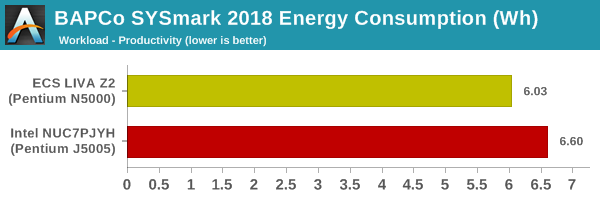
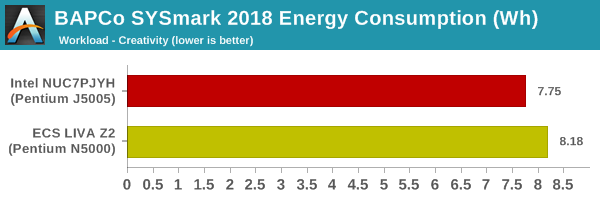
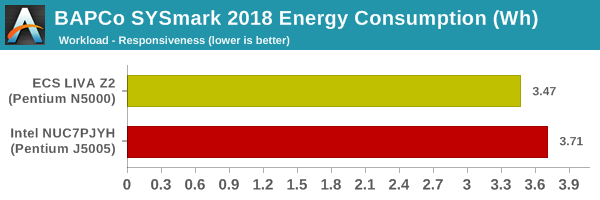
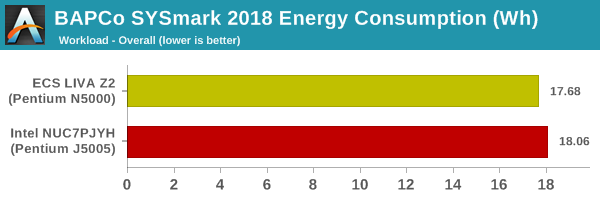
Despite being passively cooled, the ECS LIVA Z2 manages to put up a credible fight against the actively-cooled Arches Canyon NUC. Other than that, the scores are along expected lines, with the June Canyon NUC coming out on top (due to its use of the most powerful Gemini Lake SoC available).










59 Comments
View All Comments
DigitalFreak - Thursday, December 20, 2018 - link
What does it say about Intel Ethernet controller pricing when they use a 3rd party one on their own system?JoeyJoJo123 - Thursday, December 20, 2018 - link
I was going to ask about that.I don't want to come across as "realtek ethernet BAD", but the reality is that for FreeBSD OS, Intel LAN drivers are more mature and have generally better performance. You'd think Intel would use an in-house ethernet controller for their in-house NUC, but they went with Realtek...
Is there a particular reason to go with a Realtek controller in an Intel product? Or is it really just a cost-cutting measure?
HStewart - Thursday, December 20, 2018 - link
It probably a factor that this is Pentium CPU and chipset does not support it on low end - but they wanted to add it.Hixbot - Thursday, December 20, 2018 - link
Any reason a "Top Five Black Friday Tips" video has to cover half the page?mode_13h - Friday, December 21, 2018 - link
Maybe because you're monitor is too small.:-]
mode_13h - Friday, December 21, 2018 - link
Gah, your.Hixbot - Tuesday, January 1, 2019 - link
It's a phone so yea. My question was directed to the web design team.dj_miggy - Thursday, January 3, 2019 - link
LOLzepi - Friday, December 21, 2018 - link
Maybe it tells more about Intel's fab capacity issues. Maybe they rather stop making low margin consumer level ethernet controllers to use that silicon for higher margin products.mode_13h - Friday, December 21, 2018 - link
I had the same thought, after the last NUC review. Margins too low = Intel can't even...